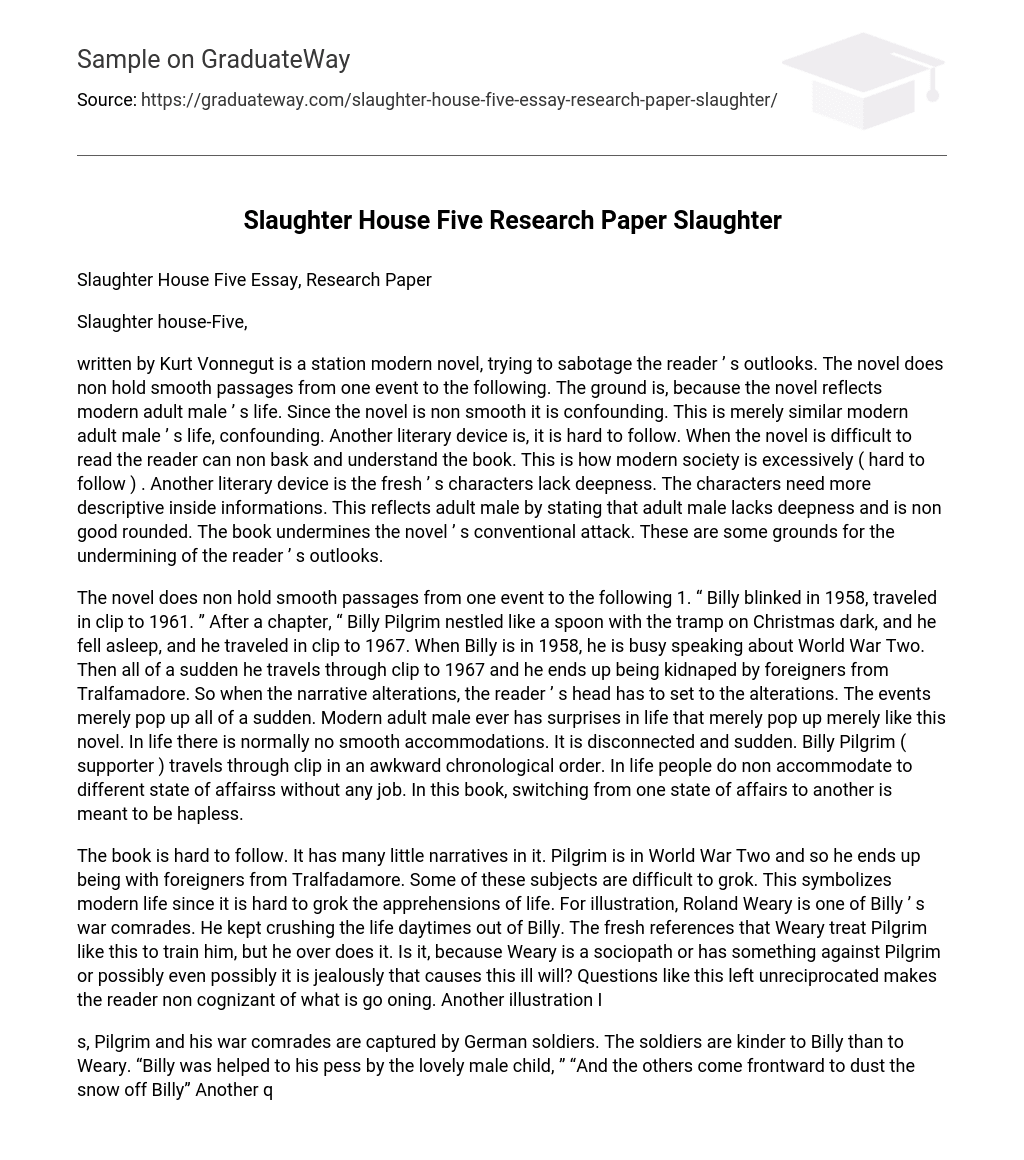Slaughter House Five is an essay that has been researched.
Slaughterhouse-Five,
Kurt Vonnegut’s novel is a contemporary piece of literature that aims to challenge the reader’s perspectives. Unlike traditional novels, it lacks smooth transitions between events, mirroring the complexity of modern life. The fragmented nature of the novel can be confusing, similar to the confusion experienced in today’s society. Another literary technique used is its challenging readability, making it difficult for readers to enjoy and understand the book, much like navigating through the complexities of modern life. Additionally, the novel’s characters lack depth and descriptive details, reflecting a lack of depth and roundedness in humanity. By undermining conventional storytelling approaches, the novel further challenges the reader’s expectations. These factors contribute to the undermining of the reader’s outlook.
The novel lacks smooth transitions between events. “Billy blinked in 1958, traveled in time to 1961.” Afterwards, in a different chapter, “Billy Pilgrim nestled like a spoon with the tramp on Christmas night, and he fell asleep, and he traveled in time to 1967.” When Billy is in 1958, he is actively discussing World War Two. Suddenly, he time-travels to 1967 and gets kidnapped by extraterrestrials from Tralfamadore. Therefore, the reader’s mind must adjust to these abrupt changes when the narrative shifts. The events appear suddenly and unexpectedly. Just like this novel, modern man always encounters surprising moments in life. Life’s adjustments are rarely smooth; they are disjointed and sudden. The protagonist, Billy Pilgrim, moves through time in an awkward non-chronological order. Similarly, in life, people do not adapt seamlessly to different situations. This book intended to depict poor transitions between situations.
The book is difficult to follow as it contains multiple small narratives. Pilgrim, who is involved in World War Two, finds himself among foreigners from Tralfadamore. Some of these subjects are challenging to understand, reflecting the complexities of modern life and its apprehensions. For instance, Roland Weary, one of Billy’s war comrades, consistently torments Billy to the point of crushing his spirit. The novel suggests that Weary treats Pilgrim this way to toughen him up, but he takes it too far. It is unclear whether Weary is a sociopath or has personal issues with Pilgrim, or perhaps jealousy fuels this animosity. The unanswered questions leave the reader unaware of the true motives behind these actions. Another example is…
In the novel, s, Pilgrim and his war comrades are captured by German soldiers. The soldiers treat Billy with kindness while being harsh with Weary. “Billy was helped to his feet by the lovely male child,” and “And the others come forward to dust the snow off Billy.” Additionally, “He tore open Weary’s greatcoat and blouse. Brass buttons flew like popcorn. The bodily reached into Weary’s panting bosom as though he meant to tear out his thumping bosom.” The differing treatment of the two characters is not explained in the novel, leaving readers curious. Vonnegut intentionally avoids providing detailed descriptions of events like this to mirror real life, where unanswered questions abound and people are naturally curious. This deliberate lack of clarity contributes to the difficulty in understanding the novel.
Some side characters lack depth and need more description. For example, there was a photographer present during the war who captured images of Pilgrim and Weary when they were captured by the Germans. Vonnegut doesn’t provide any information about his background or the company he works for. He simply states, “There was a photographer present, a German letter writer with a Leica.” This lack of detail leaves readers wanting to know more about the characters, making the narrative more intriguing. Without sufficient description, readers are left with questions and curiosity, just as in real life. When there isn’t enough information about something, there is always wonder and more questions. Another symbol is that man is not deep. According to a certain interpretation of Vonnegut’s symbolism, man is not fully developed. To add depth and meaning to life, man should be engaged in a variety of activities. Vonnegut reflects this by providing short descriptions for some characters.
This book challenges the reader’s perspectives. Vonnegut deliberately defied the conventions of traditional novels while writing this novel. Traditional novels typically have a smooth narrative flow, but Vonnegut intentionally avoided that in this book. Additionally, this novel reflects the complexities of modern life. Life is not always smooth; it often involves challenging and unpredictable circumstances. Consequently, this novel is intricate and might be difficult for readers to fully comprehend. Modern life is convoluted and filled with perplexing issues. The characters in Slaughter House-Five would benefit from further exploration and description. Modern individuals crave greater meaning and depth in their lives as well. Through postmodernism, this book aims to subvert the reader’s expectations.





